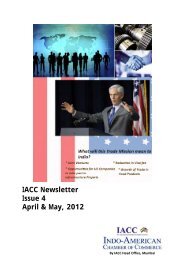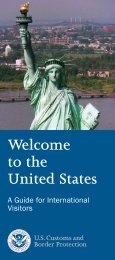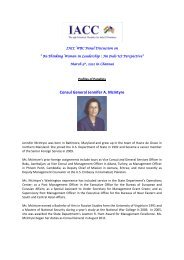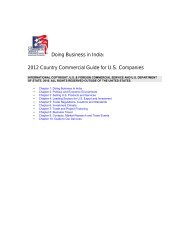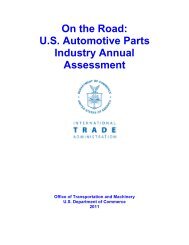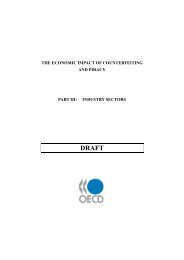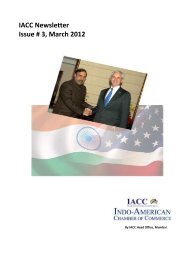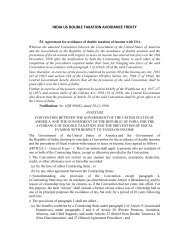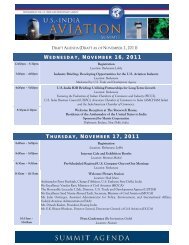Importing into the United States - Indo-American Chamber Of ...
Importing into the United States - Indo-American Chamber Of ...
Importing into the United States - Indo-American Chamber Of ...
Create successful ePaper yourself
Turn your PDF publications into a flip-book with our unique Google optimized e-Paper software.
Washington, DC 20585, is responsible for test<br />
procedures and energy performance standards.<br />
The EPACT covers <strong>the</strong> following equipment: (1)<br />
small and large commercial-package air-conditioning<br />
and heating equipment; (2) packaged<br />
terminal air-conditioners and heat pumps; (3)<br />
warm-air furnaces; (4) packaged boilers; (5)<br />
storage water heaters; (6) instantaneous water<br />
heaters; (7) unfired hot-water storage tanks; (8)<br />
large electric motors (one to 200 horsepower)<br />
whe<strong>the</strong>r shipped separately or as a part of a<br />
larger assembly; (9) 4-foot medium bi-pin,<br />
2-foot U-shaped, 8-foot slimline, and 8-foot<br />
high-output flourescent lamps; and (10) incandescent<br />
reflector lamps. In addition, <strong>the</strong> EPACT<br />
calls for water conservation standards for <strong>the</strong><br />
following plumbing products: (1) lavatory<br />
faucets; (2) lavatory replacement aerators; (3)<br />
kitchen faucets; (4) kitchen replacement faucets;<br />
(5) metering faucets; (6) gravity tank-type toilets;<br />
(7) flushometer tank toilets; (8) electromechanical<br />
hydraulic toilets; (9) blowout toilets;<br />
and (10) urinals.<br />
Importation of <strong>the</strong>se products must<br />
comply with <strong>the</strong> applicable Department of<br />
Energy and Federal Trade Commission requirements.<br />
Importers should contact <strong>the</strong>se agencies<br />
for requirements which will be in effect at <strong>the</strong><br />
time of anticipated shipment. It should be<br />
noted that not all appliances are covered by<br />
requirements of both agencies.<br />
CONSUMER PRODUCTS—SAFETY<br />
Any consumer product offered for importation<br />
will be refused admission if <strong>the</strong> product<br />
fails to comply with an applicable product<br />
safety standard or regulation or with a specified<br />
labeling or certification requirement or is<br />
determined to present a substantial product<br />
hazard. These requirements are administered by<br />
<strong>the</strong> U.S. Consumer Product Safety Commission<br />
(CPSC), Washington, DC 20207.<br />
13. Toys and Children’s Articles. Toys and<br />
o<strong>the</strong>r children’s articles cannot be imported<br />
<strong>into</strong> <strong>the</strong> <strong>United</strong> <strong>States</strong> if <strong>the</strong>y fail to comply<br />
with applicable regulations issued under <strong>the</strong><br />
Federal Hazardous Substances Act. The major<br />
regulations dealing with toys are described<br />
below. Toys or o<strong>the</strong>r articles intended for children<br />
under three years of age cannot have<br />
small parts that present choking hazards to<br />
small children. The Child Safety Protection Act<br />
(an amendment to <strong>the</strong> Federal Hazardous Substances<br />
Act) and its implementing regulations<br />
require warning labeling on toys for children<br />
who are at least three years of age, but less than<br />
six years of age, and that present choking hazards<br />
from small parts. These regulations also<br />
cover balloons, small balls (small balls for children<br />
under age three are banned), and marbles.<br />
Electric toys, rattles, pacifiers, and cribs are also<br />
subject to specific safety regulations. CPSC’s<br />
regulations contain tests used to define hazardous<br />
sharp edges and points on toys and<br />
o<strong>the</strong>r children’s articles. Lawn darts are<br />
banned.<br />
14. Lead In Paint. Paint and o<strong>the</strong>r similar surface<br />
coating materials intended for consumer<br />
use are banned if <strong>the</strong>y contain more than 0.06<br />
percent lead. This ban also applies to furniture<br />
with paint that exceeds 0.06 percent lead and to<br />
toys or o<strong>the</strong>r articles intended for use by children<br />
with paint that exceeds 0.06 percent lead.<br />
Such products cannot be admitted <strong>into</strong> <strong>the</strong><br />
<strong>United</strong> <strong>States</strong>. Although this ban applies to<br />
“surface coatings,” CPSC can take action,<br />
under <strong>the</strong> Federal Hazardous Substances Act,<br />
against o<strong>the</strong>r lead-containing products if <strong>the</strong><br />
lead content results in a substantial risk of<br />
injury or illness.<br />
15. Bicycles and Bicycle Helmets. Bicycles<br />
cannot be admitted unless <strong>the</strong>y meet regulations<br />
issued under <strong>the</strong> Federal Hazardous Substances<br />
Act. The CPSC also has mandatory<br />
safety standards for bicycle helmets. Bicycle<br />
helmets imported after March 10, 1999, will not<br />
be admitted unless <strong>the</strong>y meet CPSC’s final<br />
Safety Standard for Bicycle Helmets. At that<br />
time, bicycle helmets will need to be accompanied<br />
by a Certificate of Compliance. Bicycle<br />
helmets currently imported must meet one of<br />
several interim standards.<br />
16. Fireworks. The fireworks regulations issued<br />
under <strong>the</strong> Federal Hazardous Substance Act set<br />
labeling requirements and technical specifications<br />
for consumer fireworks. Large fireworks,<br />
such as cherry bombs and M-80s, are banned<br />
for consumer use. Large reloadable mortar<br />
shell fireworks are banned, and large<br />
multiple-tube mine and shell fireworks are sub-<br />
74 U.S. CUSTOMS SERVICE



